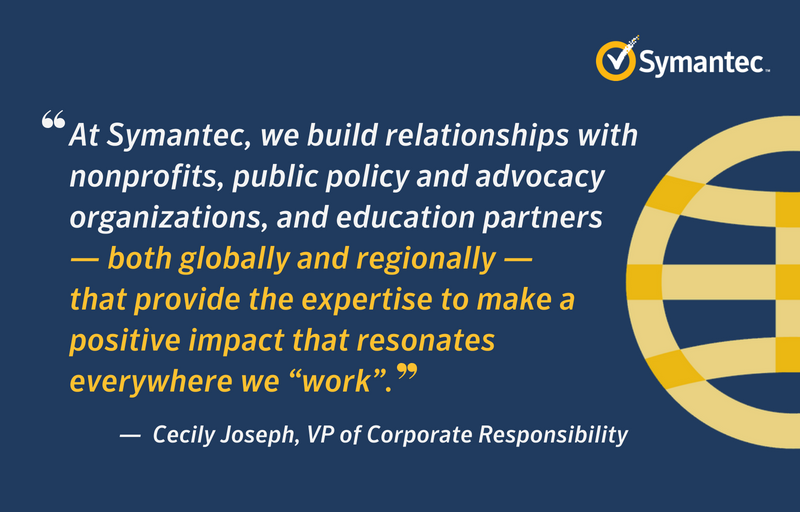Impact That Resonates Everywhere You Work
CR Experts Weigh in on the Trends Shaping Their Regions – And the World

Symantec Blog | Corporate Responsibility
by Cecily JosephVP, Corp Social Responsibility
Engaging nonprofits, public policy and advocacy organizations, and issue experts – both globally and regionally – provides the expertise companies need to make a positive impact that resonates everywhere they “work”. Symantec’s CR partners offer their insights on the trends shaping the future of CR.
Susan McPherson highlighted in her January Forbes article 8 Corporate Responsibility Trends to Look for in 2018, “events of the past year have tested companies in a number of ways and changed mainstream discourse about the role corporations should play in advancing and addressing social and global challenges.” As corporate responsibility (CR) becomes more central on the business agenda, it is also becoming increasingly complex.
To address global issues at scale, yet account for a multifaceted regional network, it is challenging to prioritize efforts – or even to know where to start. At Symantec, we build relationships with nonprofits, public policy and advocacy organizations, and education partners – both globally and regionally – that provide the expertise we need to make a positive impact that resonates everywhere we “work”.
For example, our first CR partnership was with the United Nations Global Compact (UNGC) whose 10 Principles ranging from human rights to environmental sustainability continue to guide our CR strategy. As the world’s largest corporate sustainability initiative, UNGC has grown to represent over 9,700 companies and is leveraging its unique local network based in 76 countries to “mobilize a global movement of sustainable companies and stakeholders to create the world we want.”
From Ceres to CECP to CSR Asia and Business in the Community Ireland, we bring you insights from some of our partners and experts who weighed in on the trends shaping their regions – and in many cases the world.
Ceres: The rise of policy advocacy and collaborative activism
In the United States, collective action from the business sector on climate, clean energy and water policy advocacy at the federal, state and local level has grown tremendously over the past few years. Companies increasingly recognize the need to turn outside their four walls and engage in policy discussions in order to begin to tackle large-scale issuessuch as climate change that can be economic opportunities if addressed appropriately.
As a leading U.S. organizer of investor and company support for climate, clean energy and water resilience policies, we have expanded our efforts to connect corporate America with decision-makers. The Ceres BICEP Network is comprised of some of the most influential companies advocating for stronger climate and clean energy policies at the federal and state levels, while the Connect the Drops campaign of major companies operating in California advocates for smart and sustainable water management policies. BICEP is currently at 49 companies and active in nine states, recently welcoming Adobe, Kaiser-Permanente and Salesforce to its historic base. Connect the Drops added eight new companies this spring.
We continue to help our members raise their voice on critical issues, weighing in on policies to expand clean energy solutions, reduce carbon emissions, - increase corporate access to renewable energy and assure access to clean water for all. For example, BICEP and Connect the Drops have played key roles in California, advancing smart climate, clean energy and water policies that can serve as models for other states and nations. Additionally, on the other side of the country, BICEP companies helped pass legislation in Virginia to modernize the grid and increase the availability of clean energy resources in the state. This fall, Ceres and its investor and corporate partners will be central in the first ever Global Climate Action Summit, to be held in California.
CECP: A whole company approach to valuing social investment
The trend towards developing signature causes, focus areas, or pillars, has evolved over the past decade— transitioning from thinly spread philanthropy to a strategic approach of aligning corporate responsibility programs to core business values and services.
However, how do companies value these investments? According to a Goldman Sachs study citing Bloomberg data, the explosion of sustainability or ESG reporting has led to over six million data points being reported by companies across 450 metrics in 2016.
In many cases traditional measurement of social impact doesn’t account for innovation beyond donations. Companies can now look to any portion of their business for opportunities for improvement and the integration of CR. For example, at IKEA social enterprise sits within their value chain and the same rigor is applied to the social enterprises they support as to the suppliers they bring on board. Symantec’s software donation program helps nonprofits across the world secure their data and operations, expanding the definition of “customers” for their world leading cyber security products.
CECP’s recent report with support from Cisco – “What Counts: The S in ESG New Conclusions” – highlights a new – holistic – measurement of a company’s comprehensive social engagement programming. This calculation “Total Social Investment” (or TSI), is a forward-looking reflection of the innovative ways companies invest in society.
TSI offers a high-level and comparable snapshot for use by investors and other stakeholders to determine the value created by the “S” efforts in Environmental, Social, and Governance (ESG) measures. It captures initiatives that would have previously gone unmeasured: for example, new practices such as impact investing, the employment of individuals whose job it is to provide social services or collaborating with partners that aren’t formally organized non-profit organizations.
The goal is for companies to report TSI using a shared definition by 2020 so companies can disclose the full value of their social investments and companies and stakeholders can effectively benchmark.
Business in the Community Ireland (BITCI): Building brand through impactful regional storytelling
Business in the Community Ireland, is a network of leading companies addressing sustainability challenges in Ireland. In the past, the Irish corporate culture tended to be quite reserved when it came to communicating CR impacts. However, today that is changing vastly.
The drivers are now there to tell the story – both within Ireland and globally – and it has become the differentiator in the war on talent. Regulation such as the EU Directive on Non-financial and Diversity Information has added to this as large public interest companies within Member States must now be able to effectively report on ESG impacts.
However, many companies are struggling to fully communicate the value and impact of corporate responsibility both internally and externally. For example, a lot of our member companies don’t have adequate systems to track regional impact data or to communicate their impacts, to tell that wholesome story.
For this reason, BITCI created the Business Impact Map to showcase the impact that BITCI member companies are making across Ireland and to provide a holistic picture of the collective impact of the BITCI Network. For the calendar year 2017, the map represents almost €28M worth of corporate support to the community and voluntary sector in Ireland and over 235K volunteer hours. In the last five years, employees from BITCI member companies have volunteered over one million hours. Alongside the impact map, each year we launch an extensive communications campaign to connect these strong stories to the stakeholders who care about them. This year, our campaign #strongertogether launched in March and featured a story on Martin Coughlan, software engineer at Symantec who is an ambassador for online safety and cyber bullying at schools across Dublin.
In its seventh year, the impact map is seen as a stepping stone to something bigger. For example, we are looking at how to move beyond the “inputs” to quantifying impact. The map isn’t perfect by any means, but it’s a way to sustain an important conversation about how business can make an impact.
CSR Asia: The exponential growth of CR in Asia
Over the last 5-6 years we have seen exponential growth in the number of Asian-based companies adopting CSR and sustainability principles into business strategy. Among the CSR leaders in the region is Huawei which acknowledges that to be a truly global brand the company needs to lead on sustainability issues material to the industry. Huawei has been championing the Sustainable Development Goals (SDGs) at an international level, with an emphasis on SDG4: Quality Education, and the role ICT can play in realizing education for all by 2030. While many companies are progressing their sustainability and CSR agendas, most companies are facing challenges when it comes to defining a strategic framework for and understanding the actual impact of their efforts.
CSR Asia’s Tracking the Trends, an annual expert stakeholder research, provides a snapshot of the sustainability and corporate responsibility topics and trends likely to emerge and how stakeholders expect businesses to respond.
Since 2015, climate change has remained top of the list while supply chain and human rights has moved up into second place. In 2016, the Sustainable Development Goals appeared, and have since moved up from sixth to third place this year. Additionally, in 2018, when looking at the most influential groups, NGOs were replaced at the top by companies.
Creating positive impact everywhere you work
It is exciting and promising that business is stepping up on so many fronts. However, it presents a new challenge and responsibility for global companies and their CR teams – one that requires calling on issue-based and regional experts. To ensure you can create global impact that has value everywhere you work.

